Egyptian Air Defense Forces
| Egyptian Air Defense Forces | |
|---|---|
| قوات الدفاع الجوي المصري | |
|
Egyptian Air Defense Forces insignia | |
| Active | 1968–present (48 years) |
| Country |
|
| Allegiance | Egypt |
| Branch | Air Defense |
| Role | Anti-aircraft warfare |
| Size |
80,000 personnel (As of 2014)[1] 70,000 Reserve (As of 2014)[1] 150,000 Totals (As of 2014)[1] |
| Part of |
|
| Garrison/HQ | Cairo, Egypt |
| Nickname(s) | حصن السماء Sky Fortress |
| Motto(s) | إيمان, عزم, مجد Faith, Will, Glory |
| Anniversaries | 30 June |
| Equipment | Equipment of the Egyptian Air Defense Forces |
| Engagements |
World War II 1948 Arab–Israeli War Tripartite Aggression Six-Day War War of Attrition October War Gulf War |
| Website | www.mod.gov.eg |
| Commanders | |
| Commander of the Egyptian Air Defense | Lt. Gen. Abd Al-Moniem Al-Terras |
| Chief of Air Defense Staff | Maj. Gen. Ali Fahmi Mohammed Ali Fahmi |
| Insignia | |
| Flag |
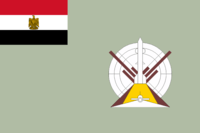 |
| Insignia | Egyptian Army ranks |
The Egyptian Air Defense Forces or EADF (Arabic: قوات الدفاع الجوي, Quwwat El-Difa' El-Gawwi), is the Anti-aircraft warfare branch of the Egyptian Armed Forces. It is responsible for protecting the Egyptian airspace against any hostile air attacks. The EADF was established in accordance with the presidential decree issued on February 1, 1968, which provided for the establishment of the Air Defense Forces as a branch, next to Navy a fourth next to the Egyptian Ground Forces, Egyptian Air Force, formerly part of the artillery and under the operation command of the Air Force. Egypt has a modern system of air defense armament, characterized by diverse sources between east and west, which is divided between anti-aircraft missiles long, medium and short-range anti-aircraft artillery systems and early warning radars.
Officers are mostly graduates of the Egyptian Air Defense Academy, located in Alexandria. The headquarters is in Cairo, and currently the Commander in Chief is Lieutenant General Abd Al-Moniem Al-Terras[2] and the Chief of Air Defense Staff is Major General Ali Fahmi Mohammed Ali Fahmi. The Egyptian air defense forces consists of 30,000 officers & soldiers plus 50,000 conscripts.[1]
Suez Crisis

Anti-aircraft guns were one of the Egyptian military strengths of World War II.[3] After the Egyptian Revolution of 1952, further development of anti-aircraft forces was part of Egypt's military buildup.
In mid-1956 the formation of a good number of units of light and medium anti-aircraft artillery began. Following the outbreak of the Suez Crisis, anti-aircraft artillery forces met with sophisticated technology not matched by arming which dates back to World War II technology, engendering aircraft anti-modern vehicles and soldiers with machine guns in a continuous raids and at low and medium altitudes, but the anti-aircraft artillery soldiers inflicted hostile forces, the largest possible losses in spite of the lack of training and the weakness of their equipment have shot down several aircraft in Cairo, Alexandria and Sinai and set up a trap for the planes tried to bomb the crossings that link the Sinai Nile Valley in the city of Suez, and Port Said forces managed to hold out for several days before the air attacks intensive aircraft aggression triangular, also participated in the popular resistance operations.[4]
Six-Day War

On June 5, 1967 the Israeli Air Force began air strikes on the Egyptian front in Sinai, taking advantage of shortcomings in the Egyptian air defense. In spite of Egypt's access to some anti-aircraft missile bases but did not not only a step on a long road of arming the diverse anti-aircraft, which had to be owned by the Egyptian Air Defense Forces to tighten control and defend the Egyptian atmosphere then, where missed to each of the anti-aircraft artillery different Boaertha and missiles of different ranges and a network of early warning and arms sufficient to defend vital targets the state of modern air fighters encountered in air attacks efficiently and commanders and crews trained to work on the equipment and weapons. Thus, the Israeli Air Force did not face any little resistance except from anti-aircraft artillery, which date back to the manufactured Second World War and that are not suitable for dealing with modern fighter aircraft with high speeds, resulting in a painful loss of life, land and equipment.[4]
War of Attrition

Following the 1967 war, Egypt took the decision to re-organize and develop its armed forces, and included those decisions on Presidential Decree No. 199 issued on February 1, 1968 establishment of the Egyptian Air Defense Forces as a branch of a major and the strength of an independent stand-alone after they had their weapons and units scattered among departments and troops with artillery and rockets were tracing artillery management units and radar warning and operations centers used to belong to the air force and the control points were given follow the Border guard.[5]
And confined all the means and weapons and equipment anti-air attacks under one command to ensure coordination and unification of responsibility and in order to achieve success, and in the June 23, 1969 was appointed Lieutenant General Mohammed Aly Fahmy as the first commander of the newly emerging forces, which carry it upon himself to reorganize the forces and the management of cadres and personnel training and increase their level of tactical and tactical mission and technical, with a broad technological base capable of accommodating modern air defense weapons as soon as possible in order to deprive Israel of air superiority configuration.[6]
Warning Network
Require the development of the Egyptian air defense system, the establishment of long-range warning network to detect any hostile aircraft approaching from the Egyptian airspace and provide enough time to warn of rockets and artillery positions, and secure the necessary current information to operate the equipment and weapons. Egypt succeeded in providing large numbers of multi-media warning and used in coordination and cooperation and promote the complementary network of checkpoints and processing network, given flexible transportation and protection against Israeli electronic attacks.[4]:10
October War
After the October war
In 1970 Egyptian Air Defense consisted of 4 divisions:
- 5th Air Defense Division placed in Cairo. Sami Hafez Anan reportedly commanded this division in 1996-98.
- 8th Air Defense division placed in Abu Suwayr
- 10th Air Defense division placed in Alexandria
- 12th Air Defense division placed in Aswan[7]
In 1989 a large share of the Egyptian Air Defense Force's equipment was imported from the Soviet Union.[8] As of 1989, the most modern weapons in the air defense system were the 108 medium altitude I-Hawk SAMs acquired from the United States beginning in 1982.[8] These weapons were supplemented by 400 older Soviet-made S-75 Dvina (SA-2) SAMs with a slant range of forty to fifty kilometers and about 240 SA-3s, which provided shorter-range defense against low-flying targets. A British firm helped the ADF modernize the SA-2s. In addition, Egypt was producing its own SAM, the Tayir as Sabah,[8] based on the design of the SA-2. The ADF had mounted sixty Soviet 2K12 Kub SAMs on tracked vehicles as tactical launchers. Sixteen tracked vehicles provided mobile launching platforms for its fifty French-manufactured Crotale SAM launchers. Egypt was also introducing its own composite gun-missile-radar system known as Amoun (skyguard), integrating radar-guided twin 23mm guns with Sparrow and Egyptian Ayn as Saqr SAMs.
Weaponry
It is undergoing extensive modernization with budgetary constraints being the only hindrance. Currently, it is believed to possess the following weaponry:
| Part of a series on |
| Armed Forces of the Arab Republic of Egypt |
|---|
| Administration |
| Service branches |
| Armies and Military Areas |
| Special Forces |
| Ranks of the Egyptian Military |
| History of the Egyptian military |
Regional/strategic perimeter-level SAM
- MIM-104 : 32 batteries (In 1999, Egypt acquired 32 missile systems from the United States for $1.3 billion)
- 9K37 Buk-M1 missile: 10 batteries purchased in 2005
- 9M317 Buk-M2 missile: Purchased in 2013. [in service with unspecified number]
- Modernized SA-3 2M Pechora missile: 43 Batteries (each with 2 stationary units, 4 missiles per stationary unit plus 1 reload each) (low/medium-altitude, medium-range SAM)
- S-300VM transportable SAM system [first components delivered in March 2015][9]
- Modernized MIM-23 HAWK "Improved HAWK" missile: 18 batteries (6 SP units per battery, 3 missiles per unit plus 2 reloads each) (medium/high-altitude, medium-range SAM)
- 9K37 Buk-M1 missile: 10 batteries purchased in 2005
- 9M317 Buk-M2 missile: Purchased in 2013. [in service with unspecified number]
- Modernized SA-3 2M Pechora missile: 43 Batteries (each with 2 stationary units, 4 missiles per stationary unit plus 1 reload each) (low/medium-altitude, medium-range SAM)
- Indigenous Tayer el-sabah (Morning Bird) (reverse-engineered and modernized SA-2 Guideline S-75 Dvina missile: 40 batteries (6 single units per Battery, 2 reloads each) (medium/high-altitude, long-range SAM)
Army corps and division-level SAM
- 9K331 Tor-M1 missile : 16 firing units
- 9K332 Tor-M2 :Purchased in 2013 [in service with unspecified numbers]
- Modernized SA-3 2M Pechora missile: 10 Batteries (6 SP units per Battery, 2 missiles per S/P unit plus 1 reload per unit) (Low/Medium Altitude, Medium Range SAM)
- Modernized SA-6 Gainful missile: 14 Batteries (6 SP units per Battery, 3 missiles per unit plus 1 reload each)(Low/Medium Altitude, Medium Range SAM)
Brigade- and battalion-level SAM
- Skyguard "Amoun" anti-aircraft system Aspide 2000 missile: 40 Batteries " 18 battalion + 4 batteries for training " (2 4-cell Aspide missile launchers and 2 Oerlikon GDF-005 twin 35mm guns with one Skyguard Fire Control System per battery).
- Modernized Crotale NG missile: 16 Batteries (9 units per Battery, 4 Missiles per unit plus 2 reloads each)(SP Low/Medium Altitude, Short Range SAM)
- MIM-72/M48 Chaparral low-altitude SAM AIM-9 "Sidewinder": 86 SP units (4 Missiles per unit plus 2 reloads each)(SP Low Altitude, Short Range SAM)
- AN/TWQ-1 Avenger : 75 Batteries ( 4/8 ready-to-fire FIM-92 Stinger missiles + .50 caliber machine gun with an electronic trigger that can be fired from both the Remote Control Unit (RCU) located in the drivers cab, and from the handstation located in the Avenger turret )( provides mobile, short-range air defense protection for ground units against cruise missiles, unmanned aerial vehicles, low-flying fixed-wing aircraft, and helicopters )
By the end of 2008, With the Support of The United-States (through FMF and private contractors\firms) all missile, radar, observation posts, command and control systems are to be linked into a complex multi-level, national computerized early-warning air defense command (C3I4) via modified EC-130H Hercules (modified to AWACS-like specifications) transport aircraft, EW AWACS "Grumman" E-2C Hawkeye 2000, EW ECM Beechcraft 1900 ELINT, underground sheltered-reinforced fiber-optic network.
Commanders of the Egyptian Air Defense Command
- June 1969 to January 1975 Field Marshal Mohammed Aly Fahmy
- January 1975 to December 1979 Lieutenant general Helmy Afify Abd El-Bar
- December 1979 to January 1986 Lieutenant general El-Said Hamdy
- January 1986 to October 1987 Lieutenant general Adel Khalil
- October 1987 to December 1990 Lieutenant general Mostafa El-Shazly
- December 1990 to April 1993 Lieutenant general Zaher Abd El-Rahman
- April 1993 to April 1996 Lieutenant general Ahmed Abo Taleb
- April 1996 to 19 July 2001 Lieutenant general Mohammed El Shahat
- 19 July 2001 to 30 October 2005 Lieutenant general Sami Hafez Anan
- 30 October 2005 to 12 August 2012 Lieutenant general Abd El Aziz Seif-Eldeen
- 12 August 2012 to Incumbent Lieutenant general Abdul Meniem Al-Toras[10]
Egyptian Air Defense equipment
| Model | Image | Origin | Type | Variant | Number | Details | |
|---|---|---|---|---|---|---|---|
| MIM-104 Patriot |  | | Long Range Air Defense | MIM-104-F/PAC-3 | 32 | In 1999, Egypt acquired 32 missile systems from the United States for $1.3 billion.[11] | |
| S-300 | 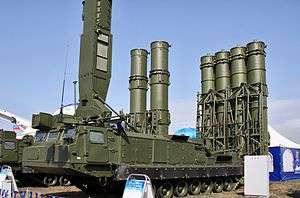 | | Long Range Air Defense | S-300VM (SA-23) | 3 Battalions[12] | The S-300VM entered service in November 2014[13][14][15][16] and is stocked in Egypt. The one billion dollar regiment includes a command post, 3 Divisions, additional elements and other contract clauses. The contract will be fully completed by the end of 2016, training of employees has already begun.[17] Russia is holding talks with Egypt on the delivery of additional Antey-2500 anti-ballistic missile systems.[18] AA Range = 200 km, AA Ceiling = 30 km, Speed = Mach 5, ABM Range = 40 km.[19] | |
| Dvina | 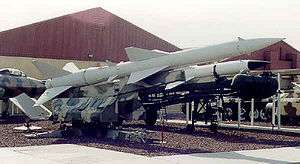 | | Medium Range Air Defense | Tayer el-Sabah SA-2 | 100[20] | 100 units were delivered by USSR from 1970 to 1972 for use in the Yom Kippur War. The Egyptian like the performance and purchased the production rights from USSR AA Range = 45 km, AA Ceiling = 25 km, Speed = Mach 3.5, ABM = none | |
| Buk |  | | Medium Range Air Defense | M1-2 M2 (SA-17) | The Buk-M2 was not previously known to be in Egyptian service until it was revealed in a video of an air defence exercise released on 2 November 2014 by the MoD.[21] AA Range = 30 km, AA Ceiling = 14 km, Speed = Mach 3.0 | ||
| MIM-23 Hawk |  | | Medium Range Air Defense | Phase III | 62 | On 25 February 2014, Egypt ordered new 186 rocket motors to extend the live of their Hawk batteries.[22] Since there are 3 missiles per launch unit then one can deduce that Egypt plans to maintain 62 launcher systems. AA Range = 50 km, AA Ceiling = 14 km, Speed = Mach 2.4 | |
| Pechora | .jpg) | | Medium Range Air Defense | 2M (SA-3) | 70 | Originally Egypt received 200 units from USSR between 1970 and 1972[20] and they were used greatly during the Yom Kippur War. These units aged and some of them were upgraded to Pechora-2M version. As of December 2008, 70 Pechora-2M upgraded ramp-launched missiles had been ordered by Egypt.[23] AA Range = 35 km, AA Ceiling = 18 km, Speed = Mach 3.1 | |
| Kub | 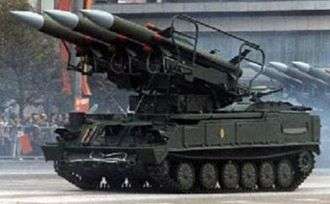 | | Medium Range Air Defense | SA-6 | 56[24] | Purchased from the Soviet Union after the disastrous 6 Day War and was used to great effect in the Yom Kippur War virtually denying the entire air space of Egypt to Israel. The system was modernized and is still in service. AA Range = 24 km, AA Ceiling = 14 km, Speed = Mach 2.8 | |
| Tor | .jpg) | | Short Range Air Defense | M1 M2 (SA-15) | 16 | 16 units were purchased from Russia.[25] The Tor-M2 was not previously known to be in Egyptian service until it was revealed in a video of an air defence exercise released on 2 November 2014 by the MoD.[21] AA Range = 12 km, AA Ceiling = 6 km, Speed = Mach 2.5 | |
| AN/TWQ-1 Avenger |  | | Short Range Air Defense | 75 | Egypt originally ordered 50 units, but in 2006 it chose to order a further 25 units which all were delivered by September 2008.[26] AA Range = 8 km, AA Ceiling = 8 km, Speed = Mach 2.2 | ||
| Crotale |  | | Short Range Air Defense | VT-1 | 36[27] | Purchased from France in 1980.[28] AA Range = 11 km, AA Ceiling = 6 km, Speed = 3.53 | |
| MIM-72 Chaparral |  | | Short Range Air Defense | MIM-72C[29] | 80[30] | Purchased from U.S. stock in 1987[28] AA Range = 9 km, AA Ceiling = 4 km, Speed = Mach 1.5 | |
| Strela-1 |  | | Short Range Air Defense | SA-9 | 20[27] | x AA Range = 4.2 km, AA Ceiling = 3.5 km, Speed = Mach 1.8 | |
| M113 AA | | | SPAAG | Nile 23 Sinai 23 M163 VADS | Upgraded version of the ZU-23-2 twin 23 mm self-propelled anti-aircraft guns radar guided (148) with Sakr Eye SAM 2X2 on M113, Upgraded version of the ZU-23-2 twin 23 mm self-propelled anti-aircraft guns radar guided with Stinger SAM (3X2) (72) on M113, 108 | ||
| Shilka | 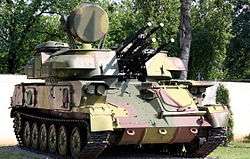 | | SPAAG | 350 in 1995.[31] 330 were delivered from USSR, also a new contract was signed with Russia in 2005.[32] | |||
| ZSU-57-2 | 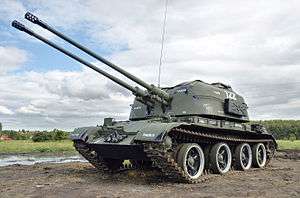 | | SPAAG | 40 | 100 ordered in 1960 from Soviet Union and delivered between 1961 and 1962,[33] with 40 remaining in storage today.[34] | ||
| M53/59 Praga |  | | SPAAG | ||||
| Oerlikon GDF |  | | Towed AA (35 mm) | Amoun | 72 | 72 Amoun units used with Skyguard and Sparrow SAM | |
| M167 VADS |  | | Towed AA (20 mm) | 72 | |||
| ZPU |  | | Towed AA (12.7 mm) | 200 | |||
| ZU-23-2 | 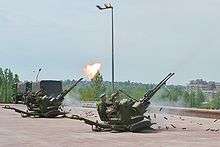 | | Towed AA (23 mm) | 280 | 280 as Nile 23 and Sinai 23, and 650 upgraded with radar guidance | ||
| 61-K | 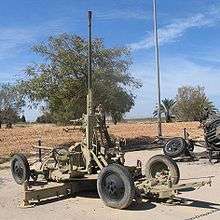 | | Towed AA (37 mm) | 200 | 700 | ||
| S-60 | 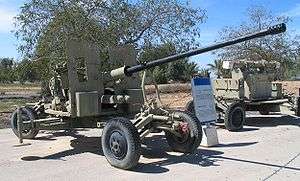 | | Towed AA (57 mm) | 200 | 600 | ||
| 52-K |  | | Towed AA (85 mm) | 400 | |||
| KS-19 |  | | Towed AA (100 mm) | 200 | |||
| KS-30 | | | Towed AA (130 mm) | 120 | [35] |
Beret
| Beret | ||
|---|---|---|
| Officer | Brigadier General | General |
 |
 |
 |
References
- 1 2 3 4 International Institute for Strategic Studies (3 Feb 2014). The Military Balance 2014. London: Routledge. pp. 315–318. ISBN 9781857437225.
- ↑ http://english.ahram.org.eg/NewsContent/1/64/50404/Egypt/Politics-/Egypts-Morsi-appoints-new-navy,-air-force-and-air-.aspx
- ↑ "Egypt". homepages.force9.net. Retrieved 2016-03-30.
- 1 2 3 Field Marshal Mohammed Aly Fahmy "Fourth power - the history of the Egyptian Air Defense Forces."ASIN 17292477
- ↑ "Al-Ahram newspaper - investigations - Zaher Abdel Rahman, a former air defense commander of the "command and control based on modern warfare."". www.ahram.org.eg. Retrieved 2016-03-29.
- ↑ Gen. Yahya Sandzak. ": Phantom aircraft downed by "ambush" air defense" – via Al-Watan newspapers.
- ↑ "ВКО". old.vko.ru. Retrieved 2016-02-24.
- 1 2 3 Metz, Helen; Chapman. "Page 367 of Egypt : A Country Study (Air Defence Forces) /". The Library of Congress, Federal Research Division. Retrieved 2016-03-17.
- ↑ "According sources, Russia would start deliveries of Antey-2500 missile systems to Egypt". 6 March 2015.
- ↑ "Commanders of the Egyptian Air Defense Command". http://www.mmc.gov.eg/. Retrieved 15 July 2013.
|first1=missing|last1=in Authors list (help); External link in|work=(help) - ↑ http://www.army-technology.com/projects/patriot/[]
- ↑ . Institute for National Security Studies http://www.inss.org.il/index.aspx?id=4538&articleid=8232. Retrieved 2015-04-03. Missing or empty
|title=(help) - ↑ ""Алмаз-Антей": российская зенитная ракетная система "Антей-2500" поствлена в Египет". ТАСС. Retrieved 14 November 2014.
- ↑ "Алмаз-Антей : российская зенитная ракетная система Антей-2500 поствлена в Египет". Retrieved 14 November 2014.
- ↑ ""Алмаз-Антей": российская зенитная ракетная система "Антей-2500" поствлена в Египет". Retrieved 14 November 2014.
- ↑ ""Рособоронэкспорт" поставит в Египет зенитные системы С-300ВМ". Рамблер-Новости. Retrieved 1 April 2015.
- ↑ "ТАСС: Армия и ОПК – Источник: Россия поставит Египту полк систем ПВО "Антей-2500" до конца 2016 года". ТАСС. Retrieved 1 April 2015.
- ↑ "Russia, Egypt Discuss Antey-2500, Buk Missile Systems Delivery".
- ↑ "S-300 & Variants". Air Power Australia. Retrieved 17 April 2015.
- 1 2 "Arms and Warfare". Retrieved 11 April 2015.
- 1 2 "Egypt reveals air defence upgrades". janes.com.
- ↑ Binnie, Jeremy (26 February 2014). "Egypt, Jordan to extend the life of HAWK missiles". IHS Jane's 360. Retrieved 3 September 2014.
- ↑ "S-125". deagel.com.
- ↑ IISS 2012 Military Balance, pp. 322
- ↑ "Tor (SA-15 Gauntlet)". Military Today.com. Retrieved 2015-04-12.
- ↑ "Avenger Low Level Air Defense System, United States of America". Army Technology.com. Retrieved 2015-04-10.
- 1 2 "The Middle East Military Balance, 2004". Retrieved 2015-04-13.
- 1 2 "Arms Diffusion: The Spread of Military Innovations in the Middle East". Retrieved 2015-04-23.
- ↑ "Egypt buys improved Chaparral" (PDF). Retrieved 2015-04-23.
- ↑ "The Middle East Military Balance, 2001–2002". Retrieved 2015-04-10.
- ↑ The World Defence Almanac 1995-1996. Military Technology. 1996
- ↑ ЗЕНИТНЫЕ САМОХОДНЫЕ УСТАНОВКИ (ЗСУ)
- ↑ "SIPRI Arms Transfers Database". Armstrade.sipri.org. Retrieved 2011-09-14.
- ↑ "Силы и средства ПВО вооруженных сил арабских государств" [Air Defense Forces of Arab States] (in Russian). Retrieved 2015-04-06.
- ↑ "Chief Designer Ardalion Rastov". Military Parade. 31 August 1998. Retrieved 23 August 2008.
External links
- Jane's Defence news on Egyptian S-125 upgrade, April 2006
- Defencetalk on Egyptian S-125 upgrade, October 2006
- http://www.kommersant.com/p718548/r_527/Egypt_arms_trade
| Wikimedia Commons has media related to Air defense of Egypt. |
